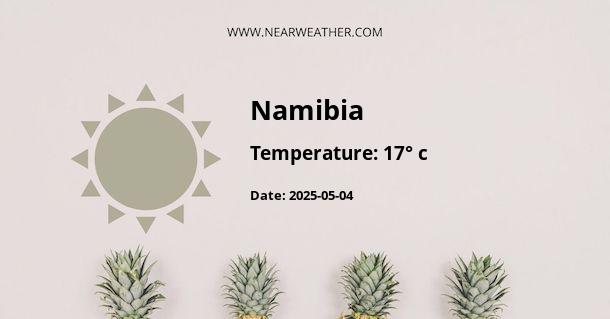Weather
29° 
Climate Conditions: broken clouds
Humidity: 27%
Wind speed: 6.3 km/h
Wind direction: 37°
Daily Weather Forecast
Saturday
11/16/2024
Climate Conditions: broken clouds
Humidity: 23%
Sunday
11/17/2024
Climate Conditions: broken clouds
Humidity: 42%
Monday
11/18/2024
Climate Conditions: clear sky
Humidity: 34%
Tuesday
11/19/2024
Climate Conditions: scattered clouds
Humidity: 32%
Wednesday
11/20/2024
Climate Conditions: scattered clouds
Humidity: 49%
Evolution
Daily Weather Forecast Evolution (°C)
Lowest temperature
Highest temperature
Other Information
Sunrise
06:01
Sunset
19:12
Latitude
-22.000000
Longitude
17.000000
Timezone: GMT+05:30
More about Namibia:
Climate and Weather in Namibia
Namibia, located in southern Africa, is known for its diverse landscapes, including the Namib Desert, the Kalahari Desert, and the Etosha National Park. The country experiences a variety of climates, from arid to semi-arid, and its weather patterns are influenced by its proximity to the Atlantic Ocean and the Sahara Desert. Understanding the climate and weather in Namibia is essential for visitors and locals alike to plan activities and be prepared for the conditions they may encounter.Seasons in Namibia
Namibia experiences four distinct seasons: summer, autumn, winter, and spring. However, it's important to note that the weather patterns and temperatures can vary significantly from one region to another due to the diverse topography of the country.Summer (November to February)
During the summer months, Namibia experiences hot and humid weather, especially in the northern regions. The average daytime temperatures range from 30°C to 40°C (86°F to 104°F), making it the hottest time of the year. The coastal areas, such as Swakopmund and Walvis Bay, experience cooler temperatures due to the Benguela Current, which has a cooling effect on the climate.Autumn (March to April)
Autumn brings a gradual decrease in temperatures, with warm days and mild evenings. This season is characterized by clear skies and less humidity, providing comfortable conditions for outdoor activities such as safaris and hiking.Winter (May to August)
Winter in Namibia is dry and mild, with significantly cooler temperatures, especially during the night. Daytime temperatures range from 15°C to 25°C (59°F to 77°F), while nighttime temperatures can drop to below freezing in the desert regions. The lack of rainfall and clear skies make winter an ideal time for stargazing, particularly in the Namib Desert.Spring (September to October)
Spring marks the transition to warmer weather, with the landscape coming alive as vegetation blooms. Daytime temperatures gradually increase, and wildlife becomes more active, making it an excellent time for nature enthusiasts to visit the national parks and reserves.Rainfall Patterns
Namibia is predominantly a dry country, with low and erratic rainfall. The amount of precipitation varies greatly across the different regions, with the north receiving more rainfall than the south. The rainy season typically occurs from November to March, with the highest rainfall amounts recorded in the northern and northeastern parts of the country.Extreme Weather Events
Namibia is prone to occasional extreme weather events, including droughts, flash floods, and sandstorms. Droughts are particularly common in the southern regions, impacting agriculture and water resources. Flash floods can occur during the rainy season, especially in areas with poor drainage systems. Sandstorms, driven by strong winds, can reduce visibility and impact travel conditions, primarily in the desert regions.Climate Charts and Statistics
To provide a visual representation of Namibia's climate, the following tables and charts present average temperature and rainfall data for selected cities across the country.Average Monthly Temperatures (Windhoek)
| Month | Jan | Feb | Mar | Apr | May | Jun | Jul | Aug | Sep | Oct | Nov | Dec | |------------|-----|-----|-----|-----|-----|-----|-----|-----|-----|-----|-----|-----| | Avg. Temp (°C) | 25 | 23 | 24 | 21 | 17 | 15 | 15 | 18 | 22 | 24 | 25 | 25 | Source: Namibia Meteorological ServiceAnnual Rainfall (Selected Cities)
| City | Windhoek | Swakopmund | Rundu | Katima Mulilo | |----------------|----------|------------|-------|----------------| | Average Rainfall (mm) | 367 | 10 | 605 | 615 | Source: Namibia Meteorological Service The average temperatures and rainfall data provide insights into the climatic conditions in Namibia, highlighting the varying patterns across different regions.Conclusion
Namibia's climate and weather exhibit a remarkable range of conditions, from scorching temperatures in the deserts to milder coastal climates. Understanding the seasonal variations and rainfall patterns is crucial for travelers and residents to make informed decisions about when to visit certain areas and how to prepare for the prevailing weather conditions. By being aware of the climate and weather trends, individuals can fully appreciate the natural beauty and diversity that Namibia has to offer. In conclusion, the climate and weather in Namibia are shaped by its geographical features and exhibit distinct seasonal characteristics, making it a captivating destination for those seeking a rich tapestry of natural landscapes and climatic experiences. Overall, Namibia's climate and weather offer a unique and diverse range of conditions, influenced by its geographical features and seasonal variations. Whether exploring the arid deserts, coastal regions, or national parks, being prepared for the weather patterns enhances the experience of this extraordinary African country.FAQ's about Namibia's Weather:
Q - What is the Latitude and Longitude of Namibia?
A - Namibia's Latitude is -22.000000 & Longitude is 17.000000.
Q - What is the weather in Namibia today?
A - Weather in Namibia is 29° today.
Q - What is the climatic condition of Namibia today?
A - Climate Conditions in Namibia shows broken clouds today.
Q - What is the humidity in Namibia today?
A - Humidity in Namibia is 27% today.
Q - What is the wind speed in Namibia today?
A - Wind speed in Namibia is 6.3 km/h, flowing at 37° wind direction. today.

Latest searched locations